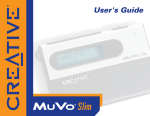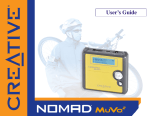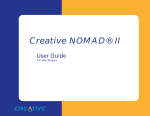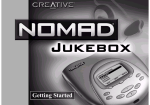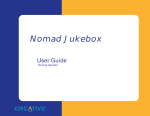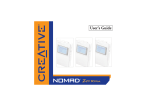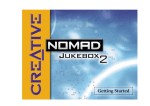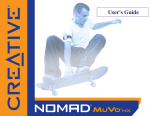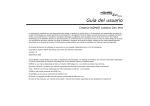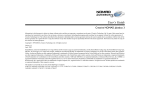Download Creative Nomad II MG User guide
Transcript
Creative Nomad II MG
User Guide
On-line Version
ii
!
"###
$
%
&#
'(
)
"###
Sound Blaster, the Sound Blaster logo, and the Creative logo are registered trademarks, and Sound Blaster Live! and Environmental Audio are trademarks of Creative
Technology Ltd. in the United States and/or other countries.
NOMAD is a registered trademark of Aonix and is used by Creative Technology Ltd. and/or its affiliates under license.
Microsoft and Windows are either registered trademarks or trademarks of Microsoft Corporation in the United States and/or other countries.
Pentium is a registered trademark of Intel Corporation.
All other brand and product names listed are trademarks or registered trademarks of their respective holders.
All specifications subject to change without prior notice. Use of this product is subject to the limited warranty. Actual contents may differ slightly from those pictured.
This product is designed to assist you in reproducing material for which you own the copyright or are authorized to copy by the copyright owner or by exemption in applicable
law. Unless you own the copyright or have such authorization, you may be violating copyright law and may be subject to payment of damages and other remedies. If you are
uncertain about your rights, you should contact your legal advisor.
!"#$%"&'(#!)*+)&!%(#%(,#$&)#-!+*%(#%(,("%(,#$&)#-!*&,!#&++&("+*#$#!'&)#$%
,!'(#%)*&"&(&#,!#&#$#!'&)#$,!'(#"&(&#%(#&!#$&)#-! !&' #*!#!(-%#$%(./"*#$&)#-!
!#""&'(##%&(("&' (*%(,%#'#&#$ &)0%%#%&()&!)!)("
#1
23
'*+(
$
'
*,+(
-,& ,
,
$
.
,
/
0
'
(
,
" )
24
,
.
1
,
'(
,
'
(
'(
,
2 2
+
.
,
1
,
,
.
,
,
3 431
,
4
5
,
.
,
,
6 &
1243
.
'&(
1
,
,
,
7 ('%
.
,
,
$
,
$
,
8 (5
* +
,
$
,
*
+
-
*+
*
+
*
+
,
*+
9 #
.
,
'(
,
'(
,
'(
$
: 43
'3
1
-
$
/
,
,
1
$
.
,
&#"42
"62
!
.
,
-
$
,
,
&&)1""+
;;<
< '=;;<=(
;;<
'
=;;<
=(
1
'=;;<
;=(
'=;;<
,=(
.
;;<
;
;;<
;;<
,
1
.
;;<
;;<
;
.)5
$>?--
)
)
5,-
)?
-@A)
;;<
;$$
B-
;;<
-)?
;;<
,-?%-?,-@-A
$,
-@A?-,,.
A-?C-;
B-?-
.
1
;;<
;
;;<
;;<
,
;;<
;
;;<
;;<
,
;;<
;;<
;
;;<
;;<
,
.
;;<
$
;;<
;;<
;
=$,
,=
;;<
;;<
;
;;<
,
;;<
;;<
,
;;<
;;<
;;<
,
1
;;<
;;<
,
;;<
;;<
;;<
;,$C,
$
D$??$-,
-@A?-,,
)?
CA-;
5;>
<5
)
C-;
)
CA-;
D$??$-,
)E
C-?B$$<.
E-,,
E)?
$
A$?5$?
A5?A),-
-
$;
)1E?>-C-
;;<
;;<
;;<
,
)
$,-
D
;;<
<-
$<-
E)?
$.
),-F5-$
)?
;-$
;$C$>-,
)?
E)?
$.
),
A?)E,
)?
),
?-%-5-,
,
,G
,G
/
,
,
/
5
/
&"
/
,
#!'%(#%&(
.
,
'
(
$
.
,
'
(
5
$
%'%#"-!!(#*
,
D
,
H
$
$
$
,
/
,
1
E
*
+
7 ###"+&%(
#$%,!'(##$&)#-!% !&%""%
-%#$&#-!!(#*&)(*8%("%#$!7 !&!
%' %"%("%(,+#(&#%'%#"#&(*%' %"
-!!(#%&)'!$(#+%%#*(")%#()&!
!#%! ! &!#%%(&#&+%,#"#&
!&%"(* "# ,!"&!#$(%
&!#)&!#$&)#-!
E
.
,
,
.
/
,
,
,
'
(
4
4
,
4
,
H
%'%##%&(&)!'"%(""',
#$&(*!'"*)&!+!$&)-!!(#*-%+
#$##)&!#$%(#$-!!(#*!"&! !%(#"
'(%(""-%#$#$&)#-!%((&(#
-%!#%&!%#%(&!+%+)&!(*
%("%!#%(%"(# %&!&(0(#%
"',&!)&!(*&# !&)%#&#%(,
&#!(&!&#"#!%%(,)!&'&!
!#%(,#&#$&)#-!&!#$%,!'(#
(%)!#%&!%#%(&!$+(
"%"&)#$ &%+%%#*&)$"',%((&
(#-%!#%9%+%%#*&!"',#&*&
&!(*&#$! !&(!7"#$'&(# %"
+**&#&#$&)#-!!,!"&)#$
)&!'&)#$%'
,
4
/
!&"#!#!(
H
,&!('(#!#!%#"!%,$#
$
,
5
5,
>
'('2('(
?
;
,
"6"""818#&2
1
,
5
,
5,
-
$
&(#!#&!:'()#!!
4C
,
I
#1
23
2&
<
A
?
,
7#::"&
% !&%%&(
(%&(
%+#&#$!& (
E
.)5
$F5?-;
B-
,)ED$?-
B-
-5?)A-$
5)
'-5(
B-
E))D>
A?)%,),
$,)
$AA.
)
.)5
E
B-?-
,
$.
),,-.
<-D--
B-
-?C,
)E
B-
,)ED$?-
-,-
$>?--C-
,-
)5
-$?-?
$;
B-
E))D>
A?)%,),
B-
E))D>
A?)%,),
,B$
$J-
A?--;--
"&' %#%&(
.
,
,K
,K
/
,
,
/
5
/
/
,(!
$
,
5,
$
,
'
(
$
,
$
%'%#"-!!(#*
7 ###"!%!%(#$%,!'(#("
!&%""("!#$$"%(,?###&!*!%,$#@
#$&)#-!% !&%""%-%#$&#-!!(#*
&)(*8%("%#$!7 !&!%' %"%("%(,
+#(&#%'%#"#&(*%' %"-!!(#%&!
&("%#%&(&)'!$(#+%%#*0%#*("
)%#()&! !#%! ! &
E
/
$
E
/
###&!*!%,$#
,
""("'#&#$'%!&&)#&)#-!%(
,!'(#;-%("&-</=
%' &!#(#><
C
'
*C
,+(
$
C
,
C
,
C
'*)?>$
A?);5+(
5
C
,
)?>$
A?);5
)?>$
A?);5
)?>$
A?);5
C
,
$
C
,
%'%##%&(&)!'"*(""',
#$%'%##%&(&)!'"%(""',%(#$
&)#-!%(,!'(#$(&# *#&
!&(%(!*;%("%(,"#$=#&(* !&(
"+*!#%9(,%,(("!+#
#&#$ !&%%&(#&#("!#$$"%(,
?###&!*!%,$#@
$
$
,
&"
&2
&3
&6
,
>
$
&9:2
'
(
,(!
$
?
,
/
-5
$
'
(
$
*<+
;
?
?
#%&(>
,$45%45
4
<C
$
K
/
4
4
/
4
/
##(#%&(>
LL/
L
M
N
L
K
M
<C
$
L
L
,$45%45
M
KL
H
GO
L
K4
G
4
K
L
/G
G
LL/
M
O
E
A
&6I
/
<
A
&6
E
?
/
/
B
/
/
I
❑ ?
❑ /
❑ /
❑ 4%
❑ <
A
&6
E
?
/
<
$
)
1
1
$
K
$,,-
*<+
KL
/
LL
CO
O
KL
;I
;
9:42274--
:"42&4--
'-C(
824"24--
'%;(
❑
$
E:7
"#9
-:61&:
C4K
I
6%
C4K$I
.<.'13+2
'24</A/
#2>;B=BCC
I6
C
I" C.:"C.
E
4
,A?""496
/
<
I
-C4-CI$,
723
&::"
E
A
&6
,
<
-,1##2
<
&6
E
?
)
I
1. This device may not cause harmful interference, and
" L
M
&6
L
E
,
E
I
1. Le matériel ne peut étre source D’interférences et
" ;
L
/
.
/
L
,
I
;$A173#"
PP
Q
C
!!!!!!!!!!!!!!!!!!!!!!!!!!!!!!!!!!!!!!!!!!!!!!!!!!!!!!!!!!!!!!!!!!!!!!!!!!!!!!!!!!!!! "
NOMAD II MG Software....................................................................................................................xi
What’s New in NOMAD II MG?...........................................................................................xii
System Requirements..........................................................................................................................xii
Windows..................................................................................................................................xii
Macintosh .............................................................................................................................. xiii
Handling Instructions ........................................................................................................................ xiii
#
$
!!!!!!!!!!!!!!!!!!!!!!!!!!!!!!!!!!!!!!!!!!!!!!!!!!!!!!!!!!!!!!!!!!!!!!!!!!!#
Optional Accessories.............................................................................................................................2
NOMAD II MG Player Controls..........................................................................................................3
Docking Station .....................................................................................................................................5
Battery Status.............................................................................................................................5
Using the Docking Station ....................................................................................................................6
%
&'($
!!!!!!!!!!!!!!!!!!!!!!!!!!!!!!!!!!!!!!!!!!!!!!!)
Step 1: Insert Batteries...........................................................................................................................7
Step 2: Insert the Flash Memory Card.................................................................................................7
Step 3: Connect Headphones to the Player ..........................................................................................8
Step 4: Install Software .........................................................................................................................8
Windows....................................................................................................................................8
Macintosh ..................................................................................................................................9
Contents
vii
Step 5: Connect NOMAD II MG Player to PC ...................................................................................9
Step 6: Verify Installation of NOMAD II MG Driver.......................................................................10
Step 7: Listen to MP3 Music...............................................................................................................10
Step 8: Listen to FM Radio.................................................................................................................10
Step 9: Make a Voice Recording.........................................................................................................10
*
'&$
!!!!!!!!!!!!!!!!!!!!!!!!!!!!!!!!!!!!!!!!!!!!!!!!!!!!!##
Overview..............................................................................................................................................11
Power ON/OFF....................................................................................................................................11
Lock......................................................................................................................................................12
Music Mode.........................................................................................................................................12
Playing a Music File................................................................................................................12
Searching Forward or Backward............................................................................................13
Repeating Playback.................................................................................................................13
Repeating a Section.................................................................................................................14
Using the EAX Equalizer .......................................................................................................14
Erasing an MP3 File................................................................................................................15
FM Radio Mode ..................................................................................................................................15
Presetting FM Radio Stations Automatically ........................................................................16
Presetting FM Radio Stations Manually ................................................................................16
Searching for a Preset Channel...............................................................................................17
Recording a Radio Broadcast .................................................................................................17
Voice Menu ..........................................................................................................................................18
Making a Voice Recording .....................................................................................................18
Playing a Voice Recording......................................................................................................18
Searching for a Voice Recording............................................................................................18
Erasing a Voice Recording......................................................................................................19
Using Time-Scaling Playback ................................................................................................19
Settings Mode ......................................................................................................................................20
Navigating and Accessing Settings ........................................................................................20
viii
Contents
Viewing Information...............................................................................................................20
Setting Time/Day ....................................................................................................................20
Setting Contrast .......................................................................................................................21
Setting Backlight on Interval ..................................................................................................21
Setting Unit Sleep Time..........................................................................................................22
Setting FM Sleep Time ...........................................................................................................22
+
'&$
,-, !!!!!!!!!!!!!!!!!!!!!!!!!!!!!%*
PlayCenter 2.........................................................................................................................................23
Changing Skins........................................................................................................................25
Formatting the Flash Memory Card ...................................................................................................25
Downloading MP3 Files .....................................................................................................................26
Managing Files ....................................................................................................................................27
Converting and Transferring Files..........................................................................................27
Deleting Files...........................................................................................................................28
Creating Play Lists ..................................................................................................................28
Connecting to the NOMAD Web Site................................................................................................30
Environmental Audio ..........................................................................................................................30
.
'&,//!!!!!!!!!!!!!!!!!!!!!!!!!!!!!!!!!!!!!*#
SoundJam and NOMAD II MG .........................................................................................................32
NOMAD II MG WINDOW ...............................................................................................................32
Opening SoundJam..............................................................................................................................33
SoundJam Controls .................................................................................................................33
Converting CD Audio to MP3............................................................................................................34
Contents
ix
0/( NOMAD II MG (DAP-6400)............................................................................................................35
1
02/& !!!!!!!!!!!!!!!!!!!!!!!!!!!!!!!!!!!!!!!!!!!!!!!!!!!!!!!!!!!!!!!!!!!!!!!!!!!!!!*)
*!!!!!!!!!!!!!!!!!!!!!!!!!!!!!!!!!!!!!!!!!!!!!!!!!!!!!!!!!!!!!!!!!!!!!!!!!!!!!!!!!!!!!!*3
What is MP3? ......................................................................................................................................39
MP3 Conversion..................................................................................................................................39
Extracting from an Audio CD ................................................................................................39
Encoding to MP3.....................................................................................................................40
MP3 Files on the Internet....................................................................................................................40
x
Contents
Your NOMAD II MG player is a digital audio player for the Internet generation. The NOMAD II MG is designed
for the active user, with features that emphasize quick setup and mobility. It is equipped with a Universal Serial
Bus (USB) connection for faster transfer rates and hot-plugging connectivity, and SSFDC (Solid State Floppy
Disk Card) compliant flash memory card support in all configurations. And,the NOMAD II MG features an FM
tuner, MP3 playback, and voice recording capability.
A key feature of the NOMAD II MG is its programmability, designed to support multiple digital audio formats,
such as Windows Media Audio (WMA) and other software extensions that will be available on
www. nomadworld.com. In addition, NOMAD II MG is designed to enable you to download support for future
digital technology, including Secure Digital Music Initiative (SDMI) compliant formats, enabling the NOMAD II
MG to play in secure formats.
The sound in the light, shock-resistant Player does not skip or fade even during vigorous exercise or after repeated
playback. The ID3 Tag information—song title and artist name—are also conveniently displayed on the LCD.
,
Your NOMAD II MG may
not include the content CD
containing MP3 music,
depending on the region in
which you purchased it.
NOMAD II MG includes the following software and music:
❑ NOMAD II Manager transfers music files such as MP3 (only from the PC to NOMAD II MG) or voice files
between NOMAD II MG and the PC
❑ Creative Digital Audio Center encodes MP3 files from audio CDs and Wave files
Mac Users: Casady & Greene’s SoundJam is the ultimate MP3 music center for the Mac—playing MP3
files, playing CD music, converting audio files, downloading files from the Internet, automatically adding
album names of your CDs along with the song titles, artist names, and more.
❑ MP3 music from a variety of MP3 providers such as Soundbuzz.com, EMusic.com, MP3.com, and Audio
Explosion, Inc.
❑ And more—additional titles may be listed when you install the NOMAD II MG software.
Introduction
xi
-/
,
4
❑ High-tech magnesium case
❑ Blue EL-backlit LCD for better viewing
❑ Play voice files at speeds up to 1.5 times faster or 0.5 slower than the original recorded speed, an advanced
voice processing capability or “Time Scaling”
❑ Record FM broadcasts
❑ 64 MB built-in memory and a flash memory card slot for adding up to 128 MB, or even 192 MB, of
additional memory (flash memory card is not included)
56
The NOMAD II MG is supported in both Windows and Macintosh environments.
-,
The minimum system requirements for NOMAD II MG are as follows:
❑ Microsoft® Windows® 98/2000
❑ 200MHz or higher Pentium (Pentium II recommended for MP3 encoding)
❑ SVGA graphics adapter (256 colors, 640x480)
❑ Internet connection for internet content downloading or CDDB support
(any charges incurred are the responsibility of the end-user)
❑ 32 MB RAM (64 MB recommended)
❑ USB port
❑ 12 MB free hard disk space (or more for audio content storage)
❑ Installed mouse
❑ Sound Blaster® Live!™ for EAX™ enhanced MP3 encoding
❑ CD-ROM drive with digital audio extraction support
xii
Introduction
/
The minimum system requirements for NOMAD II MG are as follows:
❑ Mac® OS version 8.6 or higher
❑ iMac™, G3 or higher
❑ Internet connection for Internet content downloading or CDDB support
(any charges incurred are the responsibility of the end-user)
❑ 32 MB RAM (64 MB recommended)
❑ USB port
❑ USB Manager, version 1.2 or higher
❑ 12 MB free hard disk space (more for audio file storage)
7&
❑ Do not drop the Player on a solid surface or drop a heavy object on the Player.
❑ If the Player comes into contact with water, dry it immediately with a dry cloth.
❑ If the Player becomes wet, remove the battery and flash memory card. Allow the Player and components to
dry completely before re-assembling.
❑ If the Player is not functioning, call Technical Support.
❑ Avoid storing NOMAD II where there is high humidity, strong magnetic fields, or high heat.
Introduction
xiii
1
$
Your NOMAD II MG Player includes the following items:
NOMAD II MG Player
Docking station
High-quality stereo headphones
Note: Your headphones may be
different from those shown above.
USB cable
Your NOMAD II MG may
not include the content CD
containing MP3 music,
depending on the region in
which you purchased it.
AC adapter
Software installation CD
and MP3 content CD
Protective pouch
for player
Two rechargeable
AAA NiMH batteries
Note: Use Creative’s rechargeable
NiMH batteries for maximum
playback time. Other NiMH
batteries may result in shorter
playback time.
Your NOMAD II MG
1
(
For the latest list of accessories, visit www.NOMADWorld.com
8&9:;
USB cable
AC adapter
Docking station
/
While your NOMAD II MG
Player is compatible with
SSFDC flash memory
cards, use Creative flash
memory cards to ensure
compatibility with your
NOMAD II MG Player.
2
Your NOMAD II MG
Flash memory
card
USB cable allows you to connect
the Player directly to your PC
without the docking station.
Car cassette adapter
<
Microphone
5
LCD
Flash memory card slot
Flash memory card
eject lever
Docking station connector
Battery case
Your NOMAD II MG
3
5&/
= •
•
•
•
Volume +
• Power Off (press
and hold)
• Stop
• Cancel (menu)
Volume -
Mode Select
•
•
•
•
•
• Skip track forward
• Scan frequency forward
(press and hold)
• Navigate right/down (menu)
Repeat 1
Repeat all
Repeat random
None
EAX
• Mark segment of
track to be repeated
• Store FM presets
• Skip track reverse
• Scan frequency reverse
(press and hold)
• Navigate left/up (menu)
• Record
• Erase
Lock switch: Locks the
buttons on the Player
0(
Headphone jack
NOTE: The jack is wired for a future
LCD wired remote control.
4
Your NOMAD II MG
Power On
Play
Pause
Select (menu)
Docking station connector
1
8&
Connector
Battery
status
DC adapter
jack
<
1
USB port
5
The status of the Player’s batteries is indicated by the light on the front panel of the Docking Station:
• Red (constant or blinking): Battery is being charged
Fully recharging the battery can take up to three hours; for example, if half charged, a full charge requires
approximately 90 minutes.
• Green: Battery is fully charged
Your NOMAD II MG
5
'&/
8&
To place the Player in the Docking Station:
1. Press the Player down onto the connector of the Docking Station. You
will feel a click when the Player sits snugly in the Docking Station.
Do not force the Player down.
To remove the Player from the Docking Station:
1. Hold the Player as shown in the figure to the right. Pull the Player up
and away from the connector.
6
Your NOMAD II MG
&'($
2
Your NOMAD II MG Player’s internal memory contains a “Welcome to NOMAD” MP3 song. Follow the steps
below to get started with your Creative NOMAD II MG Player and listen to the music.
(#>
1
To insert the batteries:
1. Use your thumb to slide down the battery
compartment cover.
2. Insert the batteries as shown in the diagram on the
bottom of the battery compartment.
3. Replace the battery compartment cover.
(%>
/</
To insert the flash memory card:
1. Align the flash memory card with the Player’s card slot and
insert.
2. Ensure that the flash memory card is fully inserted and the
eject lever is pushed downwards.
To remove the card, push the eject lever upwards and take out the
card.
Setting Up Your NOMAD II MG Player
7
(*>
7(/
/
Connect your headphones to the player as shown
to the right.
(+>
,
There are separate software installation procedures for Windows and the Macintosh OS.
-,
To install the Creative NOMAD II MG software in Windows:
1. Insert the Creative NOMAD II installation CD into the CD-ROM drive. If the Setup program does not run
automatically, continue with step 2.
If the Setup program runs automatically, skip to step 4.
2. Click Start on the Windows Taskbar, and click on Run.
3. On the Run dialog, type D:\CTRUN\CTRUN.EXE (where D:\ is your CD-ROM drive) and click OK.
4. On the Creative NOMAD II setup screen, the applications to be installed are selected by default. Click the
Right Arrow button to start the installation. The Creative Product Registration dialog appears.
5. Click the Next button to register your NOMAD II MG. Otherwise, click the Cancel button.
6. Follow the instructions on the screen to continue with the installation. A message appears after the first
application is installed, informing you that the Creative PlayCenter 2 Setup is complete.
7. Click the OK button and continue to install the remaining applications.
8. When prompted to restart your computer, leave the CD in the CD-ROM drive, select the “Yes, I want to
restart my computer now” option and then click the Finish button.
Install all the programs on
the software CD before
accessing it or the MP3
content CD.
8
You can go to “Step 7: Listen to MP3 Music” on
page 10 to listen to the MP3 song on your
NOMAD II MG player.
Setting Up Your NOMAD II MG Player
/
To install the Creative NOMAD II MG software in the Macintosh OS:
1. Insert the SoundJam MP CD-ROM into your drive.
2. When the SoundJam window opens automatically, double-click the SoundJam MP Installer program.
3. If you want to install SoundJam on a hard disk other than the startup disk, click the Switch Disk button in
the Installer window. Otherwise, click the Install button.
4. When the Installer completes the installation, you are prompted to restart your computer.
5. After your Mac restarts, you may double-click on the SoundJam MP icon to start the program.
(.>
Before you begin, position your computer so that you can easily access a USB port. The USB port(s) may be
located on the front, rear, or side panel of the computer case.
To connect the Player to your PC:
1. Plug the adapter into the connector on the rear plate of the Docking Station.
2. Plug the square end of the USB cable into the USB connector on the rear plate of the Docking Station.
3. Turn on the power to the adapter.
4. Plug the flat end of the USB cable into the USB connector of the PC.
You need not switch off
your computer when you
connect your NOMAD II
MG player to the PC since
USB is Plug-and-Play.
The batteries must be in the
NOMAD II MG Player—it
is not USB powered.
Setting Up Your NOMAD II MG Player
9
(?>@ To check the driver installation in Windows:
1. Click the Start button on the Windows Taskbar, select
Settings, and click on Control Panel.
2. In the Control Panel window, double-click the System icon.
3. On the System Properties dialog, click the Device Manager
tab.
4. On the Device Manager tab page, double-click Universal
Serial Bus controllers, and then check that Creative
NOMAD II MG is present as shown in the figure to the right.
()>=
*
Press the PLAY button on the Player to display the NOMAD II MG Music mode, indicated by
in a blue oval
on the LCD. The first MP3 song title appears on the LCD. Press the PLAY button to enjoy clear digital music.
(A>=
<5
To listen to FM radio, press the MODE button to change to the FM Radio Mode. Press and hold the FORWARD
button to scan for an FM radio station.
(3>8
@
5&
To make a voice recording:
1. Press the MODE button until the
icon displays in the middle of the LCD.
2. To begin recording, press and hold the ERASE/REC button until the assigned file name appears on the display.
To stop the recording, press the STOP button.
For more details on how to use your Player, refer to Chapter 3, “Using Your NOMAD II MG Player”
10
Setting Up Your NOMAD II MG Player
3
'&$
,
Flash memory card
Lock
Repeat Segment
Battery
Repeat Random
Track
Voice mode
Music mode
FM radio mode
,
B<<
Repeat 1/ALL
Settings mode
1. Press the PLAY button to turn on the power. A message “Digital Audio in Style” appears. The Player then
displays the mode that was being used when it was turned off.
2. To turn off the power, press and hold the STOP button for more than one second.
The message “Shutting down” appears on the LCD. If the Player is idle for 15 minutes, it turns off automatically.
The Power Off time can be changed in Settings mode.
Using Your NOMAD II MG Player
11
=8
The Lock switch must be Off (Up position) before you can
use the Player’s controls.
= Lock icon
To lock the Player’s
buttons, slide the Lock
switch downwards.
To access Music mode, press the MODE button until the
LCD. The last track played is displayed.
&
<
To play a music file:
1. Press the PLAY button to play the current track; press it
again to pause.
Information about the track scrolls across the LCD once.
While paused, the Pause icon appears and blinks. More
track information then scrolls across the LCD.
During the playback, the song title, the artist name, the
album name, time elapsed, and song order are displayed on
the LCD.
2. Press the STOP button to stop playback. If held down for
longer than one second, the Player is turned off.
NOMAD II MG is easily
upgradable. Whenever new
audio formats are available,
they can be downloaded to
your computer and
programmed into the Player.
For the latest information,
visit
www.NOMADWorld.com
for any new releases.
12
Using Your NOMAD II MG Player
icon appears in the blue oval in the middle of the
5&/
When the current
track is on the flash
memory card, the
icon blinks for three
seconds.
/&
<,
18,
To search in Stop mode:
1. Press the FORWARD button or REVERSE button to skip to
the next or previous track.
5(&
28
To repeat a track:
1. Press the REPEAT button to
select Repeat Current Track,
Repeat All, or Repeat
Random, which appear in
order on the display.
To cancel the Repeat
command, press the REPEAT
button until the Repeat
indicator no longer appears
on the display.
5&/
To search in Playback mode:
1. Press and hold the FORWARD button or REVERSE button to
advance within the same track.
= Repeat
Current Track
Repeat All
Repeat
Random
Using Your NOMAD II MG Player
13
5(&
To repeat a selected section of a track:
1. Press the A-B button while a track is playing to mark the
start of a section you want to repeat; press the button again
at the end of the section.
The section plays continuously until cancelled.
= To cancel the operation, press the A-B button again.
The A-B indicator disappears from the LCD and the track
continues playing from the point at which the section ended.
'&/CD
C6E
To display the EAX Equalizer:
1. Press and hold the REPEAT/EAX button to select an option
among EAX Off, Pop, Rock, Classic, Jazz, or User that
appear in turn.
Repeat Segment
indicator
= Only the User option allows you to change the Bass and Treble
level. Set the levels quickly as the display returns to the song in
two seconds.
To set either level, press the FORWARD or REVERSE button to
select Bass or Treble, and then press the VOL + or VOL - to
increase or decrease the level.
Pop
selected
14
Using Your NOMAD II MG Player
C&*
<
To erase an MP3 from Player memory:
1. Press the MODE button to go to Music mode.
2. Select the desired track using the FORWARD or REVERSE button.
3. Press the ERASE button. A confirmation message appears on the
LCD.
Press the PLAY (Select) button to erase.
4. To cancel, press any button other than the PLAY button.
5. When the action is cancelled, the Player returns to Music mode.
<5
To access FM Radio:
1. To access FM Radio mode, press the MODE button until the FM
icon FM appears in the blue oval. The first preset channel is
selected.
5&/
= Using Your NOMAD II MG Player
15
&<
5
You can change the radio
sleep time in Settings mode.
&<
5
To automatically preset FM radio stations:
1. Press and hold the A-B button. A
message “Erase all and rescan?”
appears on the LCD.
2. Press the PLAY button to rescan for
FM radio stations.
The player scans for stations and,
when a station is found, prompts you
to save to a Preset Channel.
3. Press PLAY to accept the Preset
Channel or STOP to continue scanning
without accepting.
4. Repeat Step 3 to preset other
frequencies.
“AutoScan completed” appears on the
LCD when the process is finished.
To manually preset FM radio stations:
1. Press the FORWARD or REVERSE button once to
advance 0.1 MHz each time to scan for stations
manually.
2. Once a station is located, press the A-B button to
assign the radio frequency to the Preset Channel.
Initially, all Preset Channels
are tuned to 87.5 kHz.
Use the PlayCenter 2’s
Settings option to edit the
Preset Channels. For
details, refer to Help.
16
Using Your NOMAD II MG Player
= 5&/
= 5&/
/& /
You can set up to 32 Preset
Channels.
To select a preset channel:
1. Press the PLAY button or the STOP button to go to
the next or previous Preset Channel.
The Preset Channels can be edited by using PlayCenter 2’s
Settings option. For details, refer to Play Center 2’s online
Help.
5&/
- STEREO
- MONO
- None—no signal
received
Preset Channel
Number
5&
5
1
To record a radio broadcast:
1. Press the FORWARD or REVERSE button to access the desired
Preset Channel.
2. To start recording, press and hold the ERASE/RECORD button
until the assigned file name appears on the display.
3. Press the STOP button to stop recording.
The Player resumes playing the FM station.
5&/
Using Your NOMAD II MG Player
17
@
To access Voice mode, press the MODE button until the Mode icon
recording appears in the LCD.
8&@
5&
To make a voice recording:
1. To start recording, press and hold the REC/ERASE
button until the assigned file name appears on the
display.
By default, the recording is saved to the Player’s
internal memory; if the internal memory is full, the
recording is saved to the flash memory card.
The file name, time elapsed, and the recording icon
appear on the LCD.
2. Press the STOP button to stop recording.
appears in the blue oval. The first voice
5&/
File name
assigned by
the Player
When the memory is full, a message appears and
recording stops automatically.
The recording is in ADPCM format—the same format as
a voice recording. The recorded quality is not as good as
that of the FM radio broadcast.
&@
5&
To play a voice recording:
1. Press the PLAY button to play back the current track. The name of the file scrolls across the LCD followed
by the playing time remaining.
Press the PLAY button again to pause.
To resume the playback of the current track, press the PLAY button again.
/& @
5&
The process for locating a particular voice recording is the same for locating an MP3 track. See “Searching
Forward or Backward” on page 13.
18
Using Your NOMAD II MG Player
C&@
5&
The track numbers are
adjusted immediately when
a track is added or removed.
'&0F
&
28
The maximum playback
speed is 1.5 times the
recorded playback speed
and the minimum speed is
0.5 times.
To erase a voice recording:
1. Select a track using the FORWARD or REVERSE button.
2. After selecting a track, press the ERASE button.
A confirmation message appears on the LCD.
3. Press the PLAY button to erase.
4. To cancel the operation and not erase the track, press either the STOP
or MODE button.
5. When the action is cancelled, the Player returns to the last played track
remaining.
Creative EAX’s time-scaling technology allows you to vary the speed of
audio playback.
To activate time-scaling playback:
1. Press and hold the REP/EAX button to activate time-scaling playback.
The “Time Scaling 1.00x” message appears on the LCD.
2. Press the VOL + or VOL - buttons on the Player to increase or
decrease the time-scaling playback speed.
5&/
= Using Your NOMAD II MG Player
19
&
To access Settings mode, press the MODE
button until the Settings icon
appears in
the blue oval. Two rows of icons appear
in the LCD and
is highlighted.
&&
&
&
To access the Settings icons:
1. Press the FORWARD button to navigate to
the next icon on the right or below. Press
the REVERSE button to navigate to the
previous icon on the left or up.
2. Press the PLAY button to access the
settings of the icon currently selected.
3. Press the MODE button to exit Settings
mode.
5&/
Contrast
Time/Day
Information
Backlight
Unit Sleep
Timer
FM Sleep
Timer
@,&
To view Settings Information:
1. Navigate to the Information icon
and then press the PLAY button. The Information text, on available
memory, scrolls from left to right on the LCD.
&0B
To set the time and day for the Player:
1. Navigate to the Time/Day icon
and then press the
PLAY button. The Time/Day settings appear similar to
that shown.
2. Press the ERASE/REC button to change the settings.
The Hour setting blinks.
3. Press the VOL + or VOL - buttons on the Player to
increase or decrease the Hour.
4. Press the FORWARD or REVERSE buttons to select the
next or previous setting.
5. Press the PLAY button to save the selected Settings.
The word “Saving” is shown on the LCD and the new
settings appear.
The setting order is Hour,
Minutes, Seconds, AM/PM,
Day, Month, Year, and Day
of the week.
To increase or decrease any
value, press and hold VOL +
or VOL -.
20
Using Your NOMAD II MG Player
= 5&/
&
The maximum Contrast
level is 30 and the minimum
level is 0.
&18&/
The maximum Backlight
period is 10 seconds. The
Player does not activate the
Backlight if the duration is
set to “Off”.
To set the Contrast:
1. Navigate to the Contrast icon
and then press the
PLAY button.
The Contrast setting appears with the level blinking.
2. Press the VOL + or VOL - buttons on the Player to
increase or decrease the contrast level.
3. Press the PLAY button to save the selected settings. The
word “Saving” is shown on the LCD and the new setting
appears.
The Player LCD is illuminated by backlighting.
To set the Backlight interval:
1. Navigate to the Backlight icon
and then press the
PLAY button. The Backlight setting appears as shown
with the duration blinking.
2. Press the VOL + or VOL - buttons on the Player to
increase or decrease the period the backlight is
activated.
3. Press the PLAY button to save the selected settings.
The word “Saving” is shown on the LCD and the new
setting appears.
= 5&/
= 5&/
Using Your NOMAD II MG Player
21
&'
(0
Every press of the VOL + or
VOL - increases or
decreases the time by 15
minutes. The maximum
time is 24 hours. The Player
does not shut off if the
duration is set to “Off”.
Also, when in FM mode, the
FM Sleep Timer setting
overrides the Unit Sleep
Timer setting.
&<(
0
22
Unit Sleep time is the period of inactivity before the Player
turns off automatically.
= 5&/
= 5&/
To set the Unit Sleep time:
1. Navigate to the Unit Sleeps icon
and then press
the PLAY button. The Unit Sleeps setting appears as
shown, with the time blinking.
2. Press the VOL + or VOL - buttons on the Player to
increase or decrease the shut-off time period.
3. Press the PLAY button to save the selected settings.
The word “Saving” is shown on the LCD and the new
setting appears.
FM Sleep Time is the period of inactivity before the FM Radio
automatically shuts off.
To set FM Sleep Time:
1. Navigate to the FM Sleep Time icon
and then
press the PLAY button. The FM Sleep Time setting
appears as shown, with the time blinking.
2. Press the VOL + or VOL - buttons on the Player to
increase or decrease the time after which the radio
automatically shuts off.
3. Press the PLAY button to save the selected settings.
The word “Saving” is shown on the LCD and the new
settings appears.
Using Your NOMAD II MG Player
'&$
,-,
4
This chapter describes only the basic tasks available with PlayCenter 2. For more information, see the
PlayCenter 2 Help file by clicking the question mark (?) on the PlayCenter 2; or click Start on the Taskbar,
choose Programs, choose Creative, choose PlayCenter 2.0, and click on Creative PlayCenter 2.0 Help.
%
Creative PlayCenter 2 allows you to manage the contents on your NOMAD II MG:
❑ Play MP3 files on the NOMAD II MG.
❑ View and manage the contents of the NOMAD II MG.
❑ Upload MP3 and other files to the NOMAD II MG.
❑ Download the contents (except MP3 files) to the computer.
To open PlayCenter 2:
1. Connect NOMAD II MG to your
computer. (See “Connecting the
NOMAD Player to a Computer” on
page 8.)
2. You can start PlayCenter 2 by either
of the following methods:
• Double-click on the PlayCenter
2 icon on the Windows Desktop.
• Click Start on the Windows
Taskbar, select Programs, select
Creative, select Creative
PlayCenter 2.0, and click on
Creative PlayCenter 2.0.
Using Your NOMAD II MG Software in Windows
23
To access help information:
1. On the PlayCenter 2, click the question mark (?) in the upper right corner.
2. On the Help screen, double-click the book
icon to display additional topics.
To change the PlayCenter 2 settings:
1. Click on the Settings
button to display the Setting
dialog.
2. Click on one of the tabs to display the dialog on which
changes can be made to the PlayCenter 2:
• PlayCenter 2: Selects modules (Audio CD, My
Computer, NOMAD II MG, PC Music Library) to be
displayed on either panel.
• PC Music Library: Assign folder for storing files on
your PC’s hard disk drive.
• My Computer: Select the types of media files that you
want PlayCenter 2 to display.
• CD Ripping: Configure a CD-ROM drive for digital
audio extraction.
• Encoder: Select between MP3, WMA and WAV
compression methods.
• CDDB: Select whether or not to automatically retrieve CDDB information for audio CD.
• Transfer: Select options for file transfer.
To play a track using PlayCenter 2:
1. Click the NOMAD II MG button.
2. Double-click All Tracks to display all of the tracks available.
3. Select a track from the list and press the play
button at the bottom of the window.
You may listen to the track only through devices attached to the II MG, such as headphones or speakers.
24
Using Your NOMAD II MG Software in Windows
/&&8
The PlayCenter 2 display is excellent for managing and transferring files between your NOMAD II MG and your
PC. However, the alternate skins provide a more user-friendly access to playing and listening to tracks while
connected to the computer.
To change the PlayCenter 2 skin:
1. On the PlayCenter 2 display, click the Settings button.
2. Click on the Change Skin tab.
3. On the Change Skin tab page, select the skin that
appeals to you. The each skin is previewed as you
select it in the list of available skins. When the skin you
want is shown in the preview, click OK to return to
PlayCenter 2.
4. To switch to the skin you have chosen, click the Skin
icon
on the PlayCenter 2 display.
<&/
</
Formatting a flash
memory card deletes any
existing files.
To format the flash memory card:
1. Select the icon for the flash memory card:
• Open the View menu by clicking on the arrow at the
top left of the PlayCenter.
• Click on Flash Memory Card.
2. With the Flash Memory Card contents displayed, click
the Format icon.
If the flash memory card is already formatted, you can add or
delete files to the card.
If you change the flash memory card, click the Refresh button
card.
Format Icon
to display the file information for the new
To check the status of the flash memory card, click the View box at the top of the Player window and click
Information.
Using Your NOMAD II MG Software in Windows
25
,&
*<
You must have MP3 files
on your computer in order
to download them to
NOMAD II MG Player
You can download MP3 files located on your
computer to the NOMAD II MG Player.
To download MP3 files:
1. Connect the Player to your computer.
You may connect the Player to a USB
port while the computer is running.
2. Start Creative PlayCenter 2 by
clicking on the Start button on the
Windows Taskbar, select Programs,
select Creative, select Creative
PlayCenter 2, and click on Creative
PlayCenter 2.
3. On PlayCenter 2’s My Computer
window (on the right), click View and
browse to the folder on your computer
that contains MP3 files.
4. Select the files you want to download and then click the Transfer button.
When the download is complete, you can listen to a file on the Player.
26
Using Your NOMAD II MG Software in Windows
&&
<
You can use the PlayCenter 2 to convert and transfer files between the NOMAD II MG and your computer, add
or delete files, connect to the NOMAD web site, and upgrade the NOMAD II MG’s firmware.
&
0 &<
To convert CD audio tracks to MP3 on your hard disk drive:
1. Insert an audio CD into your CD-ROM drive.
2. Click the Audio CD button to the left of the track list window.
3. Select the drive in which the CD was placed. The list of tracks on
the CD are displayed in the track list window.
4. Click TRANSFER/RIP on the right
side of the PlayCenter 2 and select the
destination for the converted tracks,
for example, Music Library.
5. Select the track(s) to be converted and
transferred to your NOMAD II MG
(or to your PC’s hard disk drive).
6. The PlayCenter 2 shows the status of
the selected tracks in the Transfer
Queue window.
Using Your NOMAD II MG Software in Windows
27
To copy files from your hard disk to the NOMAD II MG:
1. On the PC Music Library window, select the tracks to
be uploaded to the NOMAD II MG.
2. Click the arrow button pointing to the NOMAD II MG
window.
The Transfer Queue scale at the bottom of the PC
Music Library window displays the status of the
transfer.
To transfer files from the NOMAD II MG to your computer:
1. In the My Computer window, open the folder to which
you want to copy the file from the Player.
2. Select the file in the Player that you want to copy to
your PC’s hard disk (or other destination).
3. Click the Upload button on the NOMAD II MG window to copy the file to your PC.
&<
To delete files from NOMAD II MG:
1. In the NOMAD II MG window, select the file to be deleted.
2. Click on the Delete icon to permanently remove the file from NOMAD II MG.
To delete files from your computer’s hard disk:
1. In the My Computer window, select the file to be deleted.
2. Click on the Delete icon to permanently remove the file from your computer’s hard disk. You are asked to
confirm the deletion.
&
=
28
After you create a play list on your computer, you can copy it to the NOMAD II MG.
To create a play list on the NOMAD II MG:
1. Click the NOMAD II MG button on PlayCenter 2.
2. Click the NOMAD II MG menu.
3. On the menu, select Play List.
4. Click New on the PlayCenter 2 Toolbar.
5. In the Play List box, enter a title for your play list.
Using Your NOMAD II MG Software in Windows
6. In the My Computer window, display a
music library containing the track(s) you
want to add to the play list.
7. Select the track(s) you want to add to the
play list.
8. Click the left arrow button to add the
track(s) to the play list. If the track(s) are
located on your computer, they are copied to
the NOMAD II MG.
To create a play list on your computer:
1. Click the PC Music Library button on the
PlayCenter 2 window.
2. Click Play Lists in the PC Music Library
window.
3. Click New.
4. In the Play List 1 box, enter a new name for the play list.
5. Follow the instructions, starting with number 6, above.
Using Your NOMAD II MG Software in Windows
29
&
/
-2
To connect to the NOMAD web site:
1. Click on the Internet button on PlayCenter 2.
Or, type the URL address (www.nomadworld.com) into your browser’s Location box and press the ENTER
key.
You must have a Internet service provider in order to make the Internet connection.
'(&&
<,
To upgrade the NOMAD II MG:
1. Click on the Internet button on PlayCenter 2.
Or, type the URL address (www.nomadworld.com) into your browser’s Location box and press the ENTER
key.
2. On the NOMADWorld home page, click on Software Downloads.
3. Under Downloads, look for an upgrade to NOMAD II MG (or PlayCenter 2). Follow the instructions on the
web site to download the upgrade file.
C
You may use Environmental Audio effects when recording a title from an input source, such as a CD-ROM. To
include effects, display the Recorder Settings dialog and enable CD Recording Mode, Analog; and choose an
effect. When you include the effect with the recording, it remains in the file; you must re-record the title to remove
the effect.
In the Playlist, highlight the title to which you want to add Environmental Audio effects and right-click on it. If
you add Environmental Audio effects, the title in the Playlist is preceded by “EA.”
To enhance an audio file or audio CD track with EAX:
1. Select the track to be enhanced with an EAX environment.
2. Click the EAX button to display the EAX menu.
3. Select the Effects or Environment option.
4. Click on an Effect/Environment.
5. Click on the Rip To arrow to convert the file with the EAX
enhancement.
30
Using Your NOMAD II MG Software in Windows
'&,//
5
SoundJam MP is the ultimate MP3 music center that can play MP3 files in any order. SoundJam can also:
❑ Display animated graphics.
❑ Change its look, “skin,” at your command.
❑ Play music CDs with visuals.
❑ Convert almost any kind of sound file, including those on your favorite CDs, into MP3 files that you can
transfer to your NOMAD II MG.
❑ Download new MP3 files directly from the Internet with the built-in Web menu.
❑ Play streaming music from the Internet—live broadcasts as well as commercial recordings that come in the
form of real-time transmissions, not downloadable files.
❑ Automatically fill in the names of your CDs, songs and artists by linking to CDDB, the Internet’s massive
CD-ROM information database.
❑ Serve as a database of your own music. Sort by song name, artist name, album, and much more.
With SoundJam installed there are several methods for opening and playing a music file:
❑ Files opened or created in SoundJam can be opened by double-clicking the file.
❑ Drag the file’s icon over the SoundJam icon.
Or, with SoundJam or a SoundJam window open, drag the file icon—or even the folder— to SoundJam or
the SoundJam window.
❑ With SoundJam open, open the File menu, choose Open, and navigate to the folder in which the file or files
are located. Double-click on the file you want to play.
Using SoundJam™ MP with Macintosh OS
31
When SoundJam MP is installed on your Mac and the NOMAD II MG is correctly connected to your Mac, the
main NOMAD screen appears and an entry for the NOMAD window is added to SoundJam’s Window menu.
-
-
NOMAD II MG Logo: Click this logo to launch your Web browser
and access the Creative Labs NOMAD Web site:
www.nomadworld.com. It includes music downloads, information
about the NOMAD hardware and accessories, and more.
Voice files created with the NOMAD II MG have a file name extension of .NVF. SoundJam can manipulate and
play .NVF files in the same way it works with any other file.
Content Gauge: The content gauge monitors the memory in your
NOMAD II MG.
Playlist: In the NOMAD II MG playlist, the first column lets you
list tracks by album, artist, genre, name, size or time. The
subsequent columns also allow you to list tracks by these
catorgories. The display at the top of the playlist tells you how
many items are in the playlist and how much space the files require.
MP3 file names in the NOMAD II MG playlist appear with a
maximum of eight characters followed by the.MP3 file name
extension. When the NOMAD II MG actually plays the files, the song’s full title is displayed.
Add...: Clicking this button brings up the standard Macintosh get file dialog box, where you can select files that
you want to add to the playlist. It’s much easier, however, to simply drag files from another SoundJam playlist or
the Macintosh Finder into the NOMAD II MG playlist. As soon as you drag the files, SoundJam transfers the files
to the NOMAD II MG, and keeps you updated on the transfer’s progress.
Settings...: Clicking this button brings up a window where you can select the bass, treble, balance and volume of
your NOMAD II MG.
32
Using SoundJam™ MP with Macintosh OS
(&
Once SoundJam is properly installed on your hard disk drive, it is ready for you to run and enjoy. See “Installing
the Software for Mac” on page 7 for installation instructions.
The SoundJam control panel contains a volume slider, play and stop buttons, a counter, and other features. The
illustration below identifies the controls most useful to you.
To open SoundJam:
1. Double-click on the SoundJam MP icon to start the
program.
Track Information: Toggles between the track
title, album, and artist if available.
Opens the
Playlist window.
Play Status: The box (or handle)
on the progress bar indicates the
current point in the track being
played. You can replay or skip
sections of the track by dragging
the box with the mouse.
Opens the
information window
Bass and Treble sliders.
Adjusting these controls will
deactivate the graphic equalizer
Opens the
Equalizer window
Play
Stop
Pause
Previous
Next
Eject the CD-ROM
Plays tracks in the playlist
randomly.
Plays the current track over and
over. Also, pressing again
continuously plays the entire
playlist.
Using SoundJam™ MP with Macintosh OS
33
&
*
There are several ways to convert music from a CD to MP3. The following instructions represent one of the
preferred methods.
To convert CD audio tracks to MP3 files:
1. Insert a CD into your CD-ROM drive.
2. On the Window menu, choose Audio CD (or the name
of the CD).
3. Click the name of a track that you want to convert to
MP3.
4. Click Add to Converter.
5. When you have added all of the files you want to
convert into the Converter, select “SoundJam MP3
Encoder” from the “Convert using” menu. Then,
click on the “Start converting” button.
This conversion uses the default configuration. You
may want to change the configuration later, but for
now the default settings will supply excellent quality MP3 files for your NOMAD II MG.
The “Start converting” button changes to “Stop converting” and the progress of the file conversion is shown
in a bar on the lower left of the window.
6. When the conversion is complete, the playlist window reopens displaying the newly converted MP3 files.
7. Connect the NOMAD II MG to your Mac; the NOMAD II MG window opens automatically.
8. Select the files in the SoundJam playlist that you want to load into the NOMAD II MG and drag them into
the NOMAD II MG playlist.
Or, click Add in the NOMAD II MG window and select the files you want to load into the Player.
9. Once the files are in the NOMAD II MG window, they are automatically transferred to the Player.
Other methods that you can use to convert CD tracks to MP3 files include:
❑ On the Windows menu, choose Converter. Insert a CD in your CD-ROM drive. When CD-ROM drive icon
is displayed on the desktop, double-click on it. Select the icons representing the tracks you want to convert
and drag them into the Converter window.
❑ On the Window menu, choose Converter. Open a playlist of the tracks you want to convert. Drag the track
names from the playlist into the Converter.
34
Using SoundJam™ MP with Macintosh OS
A
0/( :F?+GG;
Size (W x H x D)/ Weight
❑ 58 x 90 x 18 mm / 77.1g (without battery)
Memory
Internal memory
❑ 64MB
Type of removable memory
❑ 1 x SmartMedia™ slot
Maximum memory
❑ 128MB (64MB Internal, 64MB SmartMedia*)
❑ 192MB (64MB Internal, 128MB SmartMedia*)
Interface
❑ USB (using docking station USB cable or via optional USB cable direct)
LCD Display
❑ 85 x 51 Electro-Luminescent backlit display
Standard Playback Usage
❑ 2 x AAA NiMH Alkaline
❑ 8-10 hours for MP3/voice playback
Signal to Noise Ratio
❑ >90 dB
Frequency Response
❑ 20 Hz - 20 KHz
*
SmartMedia flash memory card not included.
Technical Specifications
35
Maximum Output
❑ 5-7 mW
Harmonic Distortion Output
❑ 0.05% at 1 khz with 32 ohm load
EAX™
❑ Five presets and one user setting: bass and treble control
Audio Codec support
❑ MPEG Audio Layer 3 (MP3) and future formats*
Firmware
❑ Flash based. User upgradable*
SDMI Compliance
❑ Hardware ready*
FM
❑ 87.5 to 108mhz
Voice Recording
❑ G721 ADPCM encoding at 32kbps. Up to four hours recording on internal memory and 64MB
SmartMedia.
*
36
Technical Specifications
Future audio codec support, firmware upgrades, and SDMI compliance will be available on
ZZZQRPDGZRUOGFRP
02/&
B
My NOMAD II MG Player is not detected automatically when I connect it to my computer (either through the
Docking Station or directly through the optional USB cable).
Your Player may not be connected correctly to the computer.
Check the connections between the Player and your computer (see“Step 5: Connect NOMAD II MG Player to
PC” on page 9).
I can’t successfully make a voice recording with the NOMAD II MG Player
or
My MP3 files don’t play.
The flash memory card in your Player may have been incompletely or incorrectly formatted.
Reformat the flash memory card using NOMAD II Manager.
Troubleshooting
37
The Player isn’t able to read the flash memory card formatted with Media Card reader/writer.
NOMAD II MG only supports Solid State Floppy Disc Card (SSFDC) format (FAT12).
Windows 98 detects the Media Card reader/writer as an external removable drive in Windows Explorer. You can
only format the flash memory card into FAT16 format with the Media Card reader/writer and NOMAD II MG is
unable to recognize the FAT16 format.
To format the flash memory card, you need to obtain a software utility from the Media Card reader/writer vendor
that supports SSFDC format (FAT12).
My computer doesn’t recognize the NOMAD II MG Player when it’s connected.
The Player may not be correctly connected or the drivers may not be correctly installed on your computer.
Check the connections (see “Step 5: Connect NOMAD II MG Player to PC” on page 9) between the Player and
your computer.
Check the driver installation by clicking Start on the Windows Taskbar, select Settings, and click on Control Panel.
On the Control Panel, double-click the System icon. Click the Device Manager tab, scroll toward the bottom of
the Device Manager window to locate Universal Serial Bus Controller, and click on the plus ( + ) sign next to the
icon. Creative NOMAD II MG must be listed.
If it is not listed or there is an exclamation point on its icon, re-install the NOMAD II MG drivers (see “Step 4:
Install Software” on page 8).
38
Troubleshooting
*
-/*4
C
MP3 is an acronym for Moving Picture Experts Group (MPEG) Layer 3—an audio data compression standard
that can reduce the size of digital sound files by a 12:1 ratio with virtually no loss in quality. It is an efficient
method of storing high-quality music or other audio content on your computer.
MP3 files can be very small—compared to the size of a commercial CD audio file—yet retain high sound quality.
MP3 files usually have the file name extension .MP3, and can be downloaded from the Internet, or can be legally
made for personal use from audio CDs that you purchase.
*
C"& It is illegal to encode MP3
files for trade or sale unless
you have the expressed and
explicit permission of the
copyright holder(s).
Audio CD extraction is the first phase in the MP3 conversion process. Extraction is the reading of data from an
audio CD and storing it temporarily on your hard drive. The audio data is extracted from the CD file by means of
an application (commonly called a ripper) and copied to a file on your computer’s hard disk drive.
The time required for extracting data from an audio CD depends on the speed of the CD-ROM drive. The speed
ratings commonly seen on CD-ROM drives—such as 8X, 24X, etc.—refers to the speed at which it can read data.
Your particular drive may be fast for data, but slow for audio.
Another factor is the condition of the CD, such as defects or scratches on its surface. When playing the audio CD
in a CD-ROM drive, the data lost due to error is negligible. But when data is read incorrectly and put through the
MP3 encoding phase, the distortion is highly noticeable. To avoid distortion, the audio CD extraction software
may read the data two or three times to make sure it is read correctly. This error-checking feature is an option in
most audio CD data extraction software—be sure error-checking is enabled in your audio CD extraction software.
MP3 Primer
39
C&
*
It is illegal to encode MP3
files for trade or sale unless
you have the expressed and
explicit permission of the
copyright holder(s).
The data extracted from an audio CD is
usually in .WAV format. The encoder reads
.WAV data and outputs MP3 data. These
data are put into an MP3 file.
MP3 encoding is the compressing of data by
transforming it into the frequency domain.
MP3 encoding/compression is quality-loss
compression and the amount of loss (of
quality) is dependent upon the sampling
rate of the output and the bit rate of the
output. The higher the sampling and bit
rates used, the better the quality of the
sound. This leads to more data storage and
memory requirements. The amount of memory required for the NOMAD II player is proportional to audio
playback time.
For optimal quality, set your encoding bit rate at 128 kbps when you create MP3 files from audio CDs using
Creative Digital Audio Center.
*<
/
40
MP3 Primer
Through Internet web sites, you can download MP3 files either with or without charge, and get information about
the latest techniques and software related with MP3.
Examples of web sites with MP3 content are:
http://www.nomadworld.com
❑ NOMAD World
http://www.Amp3.com
❑ Amp3
http://www.ArtistOne.com
❑ ArtistOne, Inc.
http://www.BigHeavyWorld.com
❑ Big Heavy World
http://www.Cductive.com
❑ Cductive
http://www.EMusic.com
❑ EMusic
http://www.Epitonic.com
❑ Epitonic
http://www.SoundClick.com
❑ Sound Click
http://www.TDMCINC.com
❑ The Digital Music Co.
0200000003003-1
























































